The Impact of Possible Decadal-Scale Cold Waves on Viticulture over Europe in a Context of Global Warming
Abstract
1. Introduction
2. Methods and Material
- Simulation of coarse-resolution future climate by means of 7 CMIP5 general circulation models (GCM) under the RCP4.5 scenario.
- Dynamical downscaling over Europe according to the RCA4-SMHI model of 7 coarse-resolution GCMs.
- Coupling of the downscaled air temperature projections with 3 phenological models for the main developmental stages of the grapevine.
- Definition of climatic suitability for premium wine production based on estimated maturity dates.
2.1. General Circulation Models: the CMIP5 Simulations
2.2. Dynamical Downscaling with a Regional Circulation Model
2.3. Phenological Models
2.4. Definition of Climatic Suitability for the Different Grapevine Varieties
3. Results
3.1. Uncertainty in Climate Projections and Model Clustering
3.2. The Spatial and Temporal Features of the Cold Waves over Europe
3.3. The Effect of the Rapid Cooling on Phenology of the Grapevine
3.4. The Climatic Suitability for Premium Wine Production During the Cold-Wave Events
4. Discussion
5. Conclusions
Supplementary Materials
Author Contributions
Funding
Acknowledgments
Conflicts of Interest
References
- OIV. Statistical Report on World Vitiviniculture; OIV: Paris, France, 2018. [Google Scholar]
- van Leeuwen, C.; Seguin, G. The concept of terroir in viticulture. J. Wine Res. 2006, 17, 1–10. [Google Scholar] [CrossRef]
- Gladstones, J. Wine, Terroir and Climate Change; Wakefield Press: Kent Town, Australia, 2011; p. 279. [Google Scholar]
- van Leeuwen, C.; Friant, P.; Chone, X.; Tregoat, O.; Koundouras, S.; Dubourdieu, D. Influence of climate, soil, and cultivar on terroir. Am. J. Enol. Vitic. 2004, 55, 207–221. [Google Scholar]
- Mozell, R.N.; Thach, L. The impact of climate change on the global wine industry: Challenges and solutions. Wine Econ. Policy 2014, 3, 81–89. [Google Scholar] [CrossRef]
- Jones, G.V. Phenology: An Integrative Environmental Science. In Winegrape Phenology, 2nd ed.; Schwartz, M.D., Ed.; Springer: Berlin, Germany, 2013; p. 610. [Google Scholar]
- van Leeuwen, C.; Darriet, P. The impact of climate change on viticulture and wine quality. J. Wine Econ. 2017, 11, 150–167. [Google Scholar] [CrossRef]
- Garcia de Cortazar-Atauri, I.; Duchêne, E.; Destrac, A.; Barbeau, G.; de Resseguier, L.; Lacombe, T.; Parker, A.K.; Saurin, N.; van Leeuwen, C. Grapevine phenology in France: From past observations to future evolutions in the context of climate change. OENO One 2017, 51, 115. [Google Scholar] [CrossRef]
- Ramos, M.C.; Jones, G.V.; Martinez-Casanovas, J.A. Structure and trends in climate parameters affecting winegrape production in northeast Spain. Clim. Res. 2008, 38, 1–15. [Google Scholar] [CrossRef]
- Caffarra, A.; Eccel, E. Projecting the impacts of climate change on the phenology of grapevine in a mountain area. Aust. J. Grape Wine Res. 2011, 17, 52–61. [Google Scholar] [CrossRef]
- Tomasi, D.; Jones, G.V.; Giust, M.; Lovat, L.; Gaiotti, F. Grapevine Phenology and climate change: Relationships and trends in the Veneto Region of Italy for 1964–2009. Am. J. Enol. Vitic. 2011, 62, 329–339. [Google Scholar] [CrossRef]
- Andreoli, V.; Cassardo, C.; La Iacona, T.; Spanna, F. Description and preliminary simulations with the Italian Vineyard Integrated Numerical Model for estimating physiological values (IVINE). Agronomy 2019, 9, 94. [Google Scholar] [CrossRef]
- Drappier, J.; Thibon, C.; Rabot, A.; Geny-Denis, L. Relationship between wine composition and temperature: Impact on Bordeaux wine typicity in the context of global warming: Review. Crit. Rev. Food Sci. Nutr. 2017. [Google Scholar] [CrossRef]
- Coombe, B.G. Influence of temperature on composition and quality of grapes. Acta Hort. 1987, 206, 23–36. [Google Scholar] [CrossRef]
- Mira de Orduna, R. Climate change associated effects on wine quality and production. Food Res. Int. 2010, 43, 1844–1855. [Google Scholar] [CrossRef]
- Sweetman, C.; Sadras, V.O.; Hancock, R.D.; Soole, K.L.; Ford, C.M. Metabolic effects of elevated temperature on organic acid degradation in ripening Vitis vinifera fruit. J. Exp. Bot. 2014, 65, 5975–5988. [Google Scholar] [CrossRef]
- Dai, Z.W.; Ollat, N.; Gomès, E.; Decroocq, S.; Tandonnet, J.-P.; Bordenave, L.; Pieri, P.; Hilbert, G.; Kappel, C.; van Leeuwen, C.; et al. Ecophysiological, genetic, and molecular causes of variation in grape berry weight and composition: A review. Am. J. Enol. Vitic. 2011, 62, 413–425. [Google Scholar] [CrossRef]
- Jones, G.V. Climate and terroir: Impacts of climate variability and change on wine. Geosci. Can. Reprint Ser. 2006, 9, 1–14. [Google Scholar]
- Schultz, H.R.; Jones, G. Climate induced historic and future changes in viticulture. J. Wine Res. 2010, 21, 137–145. [Google Scholar] [CrossRef]
- Nesbitt, A.; Kemp, B.; Steele, C.; Lovett, A.; Dorling, S. Impact of recent climate change and weather variability on the viability of UK viticulture—Combining weather and climate records with producers’ perspectives. Aust. J. Grape Wine Res. 2016, 22, 324–335. [Google Scholar] [CrossRef]
- Bentzen, J.; Smith, V. Wine Production in Denmark Do the Characteristics of the Vineyards Affect the Chances for Awards? Working Papers; University of Aarhus, Aarhus School of Business, Department of Economics: Aarhus, Denmark, 2009. [Google Scholar]
- Jones, G.V.; Davis, R.E. Climate Influences on Grapevine Phenology, Grape Composition, and Wine Production and Quality for Bordeaux, France. Am. J. Enol. Vitic. 2000, 51, 249–261. [Google Scholar]
- Duchêne, É.; Huard, F.; Dumas, V.; Schneider, C.; Merdinoglu, D. The challenge of adapting grapevine varieties to climate change. Clim. Res. 2010, 41, 193–204. [Google Scholar] [CrossRef]
- Wolkovich, E.M.; García de Cortázar-Atauri, I.; Morales-Castilla, I.; Nicholas, K.A.; Lacombe, T. From Pinot to Xinomavro in the world’s future wine-growing regions. Nat. Clim. Chang. 2018, 8, 29–37. [Google Scholar] [CrossRef]
- Stocker, T.F.; Qin, D.; Plattner, G.-K.; Tignor, M.M.B.; Allen, S.K.; Boschung, J.; Nauels, A.; Xia, Y.; Bex, V.; Midgley, P.M. Technical Summary. In Climate Change 2013: The Physical Science Basis. Contribution of Working Group I to the Fifth Assessment Report of the Intergovernmental Panel on Climate Change; Cambridge University Press: Cambridge, UK; New York, NY, USA, 2013. [Google Scholar]
- Taylor, K.E.; Stouffer, R.; Meehl, G.A. An overview of CMIP5 and the Experiment Design. Bull. Am. Meteorol. Soc. 2011, 93, 485–498. [Google Scholar] [CrossRef]
- Moss, R.H.; Edmonds, J.A.; Hibbard, K.A.; Manning, M.R.; Rose, S.K.; van Vuuren, D.P.; Carter, T.R.; Emori, S.; Kainuma, M.; Kram, T.; et al. The next generation of scenarios for climate change research and assessment. Nature 2010, 463, 747–756. [Google Scholar] [CrossRef] [PubMed]
- Meinshausen, M.; Smith, S.J.; Calvin, K.; Daniel, J.S.; Kainuma, M.L.T.; Lamarque, J.-F.; Matsumoto, K.; Montzka, S.A.; Raper, S.C.B.; Riahi, K.; et al. The RCP greenhouse gas concentrations and their extensions from 1765 to 2300. Clim. Chang. 2011, 109, 213–241. [Google Scholar] [CrossRef]
- Ollat, N.; van Leeuwen, C.; Garcia de Cortazar, I.; Touzard, J.M. The challenging issue of climate change for sustainable grape and wine production. OENO One 2017, 51, 59–60. [Google Scholar] [CrossRef]
- Malheiro, A.C.; Santos, J.A.; Fraga, H.; Pinto, J.G. Climate change scenarios applied to viticultural zoning in Europe. Clim. Res. 2010, 43, 163–177. [Google Scholar] [CrossRef]
- Moriondo, M.; Jones, G.V.; Bois, B.; Di Bari, C.; Ferrise, R.; Trombi, G.; Bindi, M. Projected shifts of wine regions in response to climate change. Clim. Chang. 2013, 119, 825–839. [Google Scholar] [CrossRef]
- Fraga, H.; Garcia de Cortazar-Atauri, I.; Malheiro, A.C.; Santos, J.A. Modelling climate change impacts on viticultural yield, phenology and stress conditions in Europe. Glob. Chang. Biol. 2016, 22, 3774–3788. [Google Scholar] [CrossRef]
- Hannah, L.; Roehrdanz, P.R.; Ikegami, M.; Shepard, A.V.; Shaw, M.R.; Tabor, G.; Zhi, L.; Marquet, P.A.; Hijmans, R.J. Climate change, wine, and conservation. Proc. Natl. Acad. Sci. USA 2013, 110, 6907–6912. [Google Scholar] [CrossRef]
- van Leeuwen, C.; Schultz, H.R.; Garcia de Cortazar-Atauri, I.; Duchêne, E.; Ollat, N.; Pieri, P.; Bois, B.; Goutouly, J.P.; Quénol, H.; Touzard, J.M.; et al. Why climate change will not dramatically decrease viticultural suitability in main wine-producing areas by 2050. Proc. Natl. Acad. Sci. USA 2013, 110, E3051–E3052. [Google Scholar] [CrossRef]
- Gleckler, P.J.; Taylor, K.E.; Doutriaux, C. Performance metrics for climate models. J. Geophys. Res. 2008, 113. [Google Scholar] [CrossRef]
- Reichler, T.; Kim, J. How well do coupled models simulate today’s climate? Bull. Am. Meteorol. Soc. 2008, 89, 303–311. [Google Scholar] [CrossRef]
- Tebaldi, C.; Knutti, R. The use of the multi-model ensemble in probabilistic climate projections. Philos. Trans. R. Soc. A 2007, 365, 2053–2075. [Google Scholar] [CrossRef]
- Flato, G.; Marotzke, J.; Abiodun, B.; Braconnot, P.; Chou, S.C.; Collins, W.; Cox, P.; Driouech, F.; Emori, S.; Eyring, V.; et al. Evaluation of Climate Models. In Climate Change 2013: The Physical Science Basis. Contribution of Working Group I to the Fifth Assessment Report of the Intergovernmental Panel on Climate Change; Cambridge University Press: Cambridge, UK; New York, NY, USA, 2013. [Google Scholar]
- Gillet, N.P. Weighting climate model projections using observational constraints. Philos. Trans. R. Soc. A 2015, 373. [Google Scholar] [CrossRef]
- Mauritzen, C.; Zivkovic, T.; Veldore, V. On the relationship between climate sensitivity and modelling uncertainty. Tellus A 2017, 69. [Google Scholar] [CrossRef]
- Sgubin, G.; Swingedouw, D.; Drijfhout, S.; Mary, Y.; Bennabi, A. Abrupt cooling over the North Atlantic in modern climate models. Nat. Commun. 2017, 8. [Google Scholar] [CrossRef]
- Moffa-Sánchez, P.; Hall, I.R. North Atlantic variability and its links to European climate over the last 3000 years. Nat. Commun. 2017, 8, 1726. [Google Scholar] [CrossRef]
- Thompson, D.W.J.; Wallace, J.M.; Kennedy, J.J.; Jones, P.D. An abrupt drop in Northern Hemisphere sea surface temperature around 1970. Nature 2010, 467, 444–447. [Google Scholar] [CrossRef]
- Jacob, D.; Petersen, J.; Eggert, B.; Alias, A.; Christensen, O.B.; Bouwer, L.M.; Braun, A.; Colette, A.; Déqué, M.; Georgievski, G.; et al. EURO-CORDEX: New high-resolution climate change projections for European impact research. Reg. Environ. Chang. 2014, 14, 563–578. [Google Scholar] [CrossRef]
- Kotlarski, S.; Keuler, K.; Christensen, O.B.; Colette, A.; Déqué, M.; Gobiet, A.; Goergen, K.; Jacob, D.; Lüthi, D.; van Meijgaard, E.; et al. Regional climate modeling on European scales: A joint standard evaluation of the EURO-CORDEX RCM ensemble. Geosci. Model Dev. 2014, 7, 1297–1333. [Google Scholar] [CrossRef]
- Thomson, A.M.; Calvin, K.V.; Smith, S.J.; Kyle, G.P.; Volke, A.; Patel, P.; Delgado-Arias, S.; Bond-Lamberty, B.; Wise, M.A.; Clarke, L.E.; et al. RCP4.5: A pathway for stabilization of radiative forcing by 2100. Clim. Chang. 2011, 109, 77. [Google Scholar] [CrossRef]
- Samuelsson, P.; Jones, C.G.; Willen, U.; Ullerstig, A.; Gollvik, S.; Hansson, U.; Jansson, C.; Kjellström, E.; Nikulin, G.; Wyser, K. The Rossby Centre regional climate model RCA3: Model description and performance. Tellus A 2011, 63, 4–23. [Google Scholar] [CrossRef]
- Samuelsson, P.; Gollvik, S.; Jansson, C.; Kupiainen, M.; Kourzeneva, E.; van de Berg, W.J. The Surface Processes of the Rossby Centre Regional Atmospheric Climate Model (RCA4); Report in Meteorology; SMHI: Norrköping, Sweden, 2014; Volume 157. [Google Scholar]
- Weedon, G.P.; Balsamo, G.; Bellouin, N.; Gomes, S.; Best, M.J.; Viterbo, P. The WFDEI meteorological forcing data set: WATCH Forcing Data methodology applied to ERA-Interim reanalysis data. Water Resour. Res. 2014, 50, 7505–7514. [Google Scholar] [CrossRef]
- van Leeuwen, C.; Garnier, C.; Agut, C.; Baculat, B.; Barbeau, G.; Besnard, E.; Bois, B.; Boursiquot, J.M.; Chuine, I.; Dessup, T.; et al. Heat Requirements for Grapewine Varieties Is Essential Information to Adapt Plant Material in a Changing Climate. In Proceedings of the 7th International Terroir Congress, Nyon, Switzerland, 19 May 2008; Volume 1, pp. 222–227. [Google Scholar]
- Parker, A.; Garcia de Cortázar-Atauri, I.; Chuine, I.; Barbeau, G.; Bois, B.; Boursiquot, J.M.; Cahurel, J.Y.; Claverie, M.; Dufourcq, T.; Gény, L.; et al. Classification of varieties for their timing of flowering and veraison using a modelling approach: A case study for the grapevine species Vitis vinifera L. Agric. For. Meteorol. 2013, 180, 249–264. [Google Scholar] [CrossRef]
- Robertson, G.W. A biometeorological time scale for a cereal crop involving day and night temperatures and photoperiod. Int. J. Biometeorol. 1968, 12, 191–223. [Google Scholar] [CrossRef]
- Wang, J.Y. A critique of the heat unit approach to plant response studies. Ecology 1960, 41, 785–789. [Google Scholar] [CrossRef]
- Garcia de Cortazar-Atauri, I.; Brisson, N.; Gaudillere, J.P. Performance of several models for predicting budburst date of grapevine (Vitis vinifera L.). Int. J. Biometeorol. 2009, 53, 317–326. [Google Scholar] [CrossRef]
- Parker, A.; Garcia de Cortazar-Atauri, I.; van Leeuwen, C.; Chuine, I. General phenological model to characterize the timing of flowering and veraison of Vitis vinifera L. Aust. J. Grape Wine Res. 2011, 17, 206–216. [Google Scholar] [CrossRef]
- Bidabe, B. Contrôle de l’époque de floraison du pommier par une nouvelle conception de l’action de températures. CR Acad. Agric. France 1965, 49, 934–945. [Google Scholar]
- Richardson, E.A.; Seeley, S.D.; Walker, D.R. A model for estimating the completation of rest for Redhaven and Elberta peach trees. HortScience 1974, 9, 331–332. [Google Scholar]
- Moncur, M.W.; Rattigan, K.; Mackenzie, D.H.; Mc Intyre, G.N. Base temperatures for budburst and leaf appareance of grapevines. Am. J. Enol. Vitic. 1989, 40, 21–26. [Google Scholar]
- Garcia de Cortazar-Atauri, I. Adaptation du Modèle STICS à la Vigne (Vitis vinifera L.): Utilisation Dans le Cadre D’une Étude D’impact du Changement Climatique à L’échelle de la France. Ph.D. Thesis, École National Supérior Agronomique, Montpellier, France, 2006. [Google Scholar]
- Wang, E.L.; Engel, T. Simulation of phenological development of wheat crops. Agric. Syst. 1998, 58, 1–24. [Google Scholar] [CrossRef]
- Greer, D.H.; Weedon, M.M. The impact of high temperatures on Vitis vinifera cv. Semillon grapevine performance and berry ripening. Front. Plant Sci. 2013, 4, 491. [Google Scholar] [CrossRef]
- Garcia de Cortazar-Atauri, I.; Chuine, I.; Donatelli, M.; Parker, A.K.; van Leeuwen, C. A curvilinear process-based phenological model to study impacts of climatic change on grapevine (Vitis vinifera L.). Proc. Agron. 2010, 11, 907–908. [Google Scholar]
- Ollat, N.; Touzard, J.M.; van Leeuwen, C. Climate change impacts and adaptations: New challenges for the wine industry. J. Wine Econ. 2016, 11, 139–149. [Google Scholar] [CrossRef]
- Dunn, M.; Rounsevell, M.D.A.; Boberg, F.; Clarke, E.; Christensen, J.; Madsen, M.S. The future potential for wine production in Scotland under high-end climate change. Reg. Environ. Chang. 2017, 19, 723–732. [Google Scholar] [CrossRef]
- Maciejczak, M.; Mikiciuk, J. Climate change impact on viticulture in Poland. Int. J. Clim. Chang. Strateg. Manag. 2019, 11, 254–264. [Google Scholar] [CrossRef]
- Sgubin, G.; Swingedouw, D.; Dayon, G.; García de Cortázar-Atauri, I.; Ollat, N.; Pagé, C.; Van Leeuwen, C. The risk of tardive frost damage in French vineyards in a changing climate. Agric. For. Meteorol. 2018, 250–251, 226–242. [Google Scholar] [CrossRef]
- Fuentes Espinoza, A. Vin, Réchauffement Climatique et Stratégies des Entreprises: Comment Anticiper la Réaction des Consommateurs? Ph.D. Thesis, Economies et finances, Université de Bordeaux, Bordeaux, France, 2016. [Google Scholar]
- Tilloy, V.; Cadière, A.; Ehsani, M.; Dequin, S. Reducing alcohol levels in wines through rational and evolutionary engineering of Saccharomyces cerevisiae. Int. J. Food Microbiol. 2015, 213, 49–58. [Google Scholar] [CrossRef]
- Kliewer, W.M.; Dokoozlian, N.K. Leaf area/crop weight ratios of grapevines: Influence on fruit composition and wine quality. Am. J. Enol. Vitic. 2005, 56, 170–181. [Google Scholar]
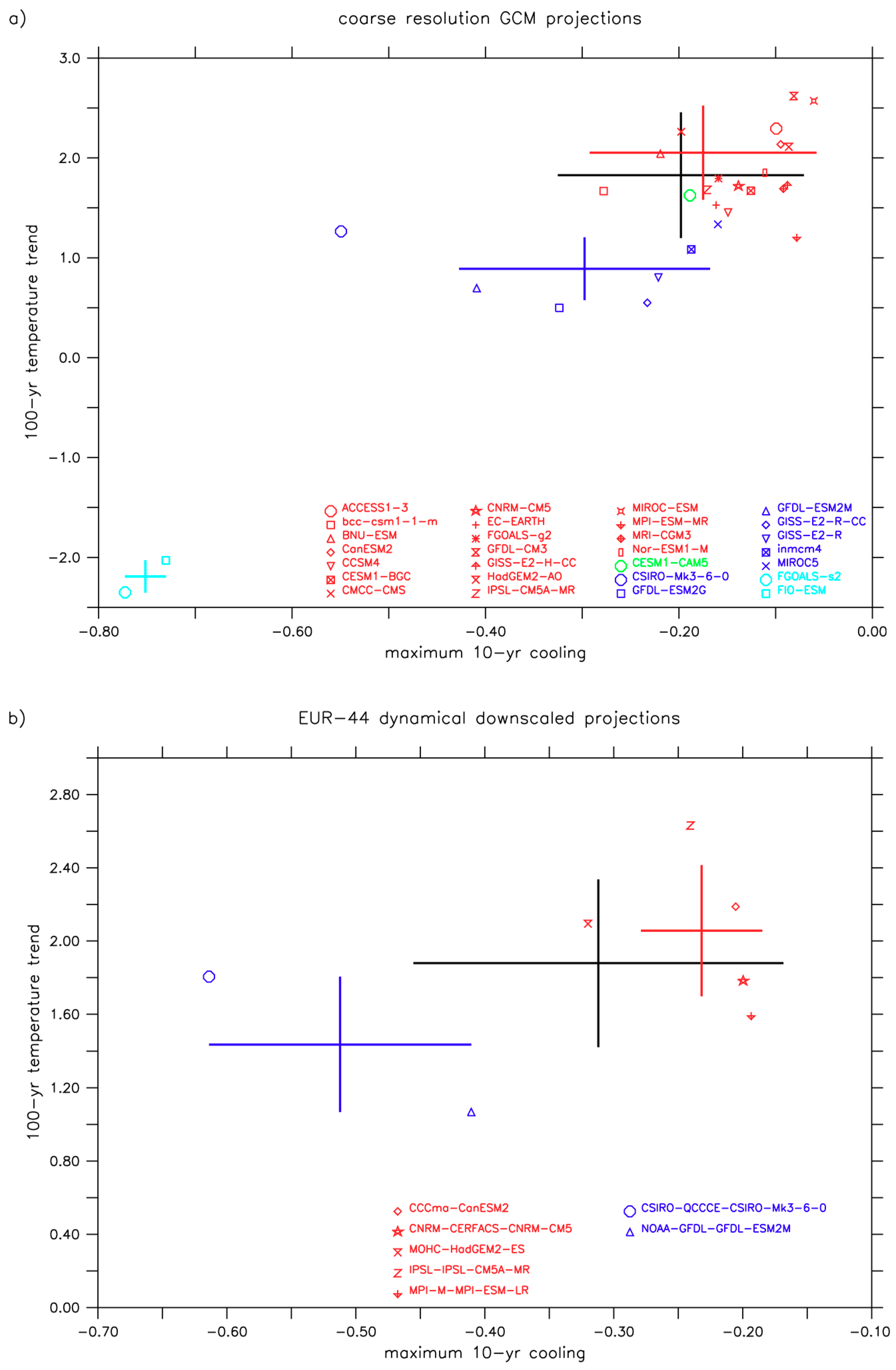

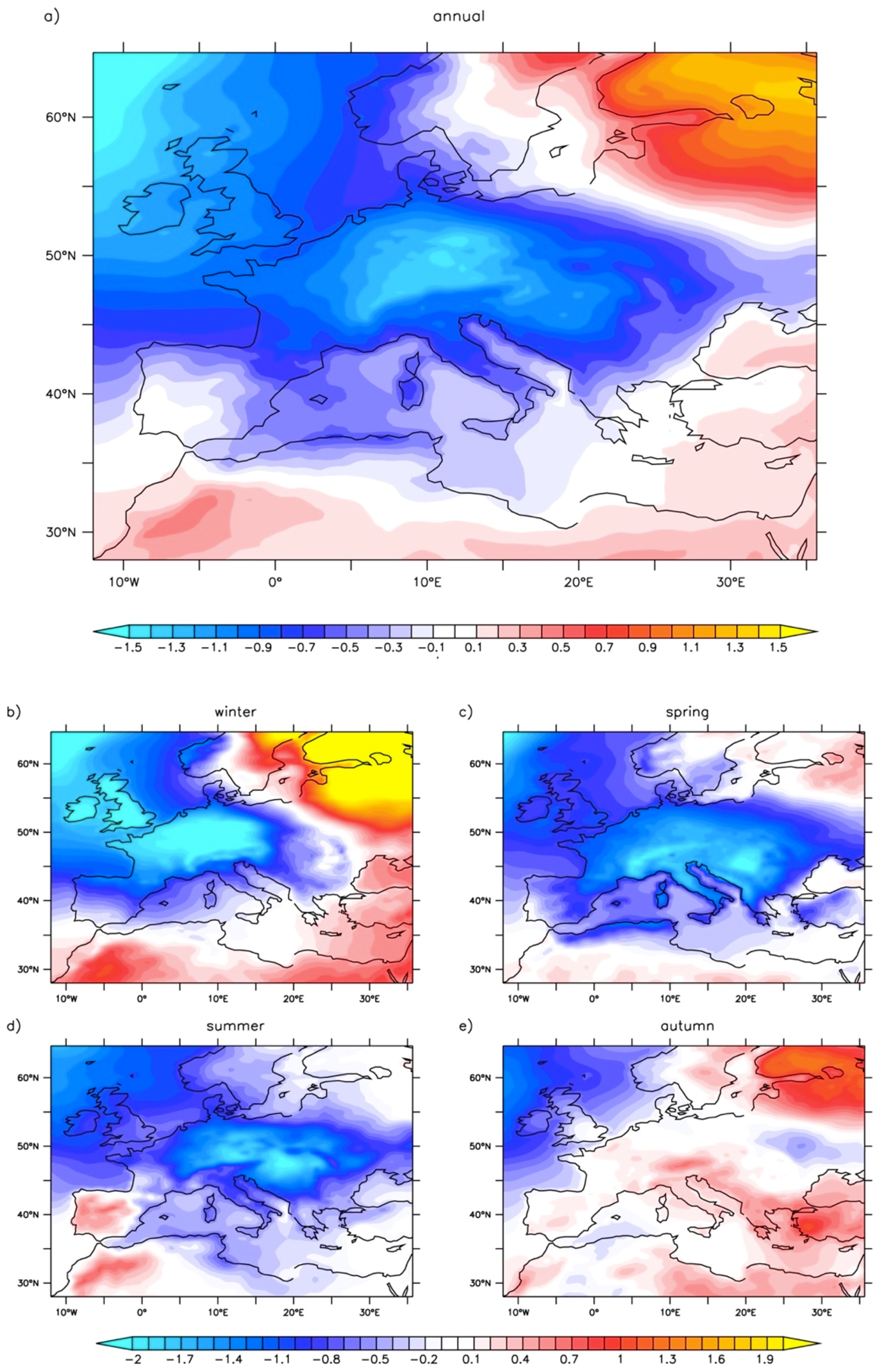

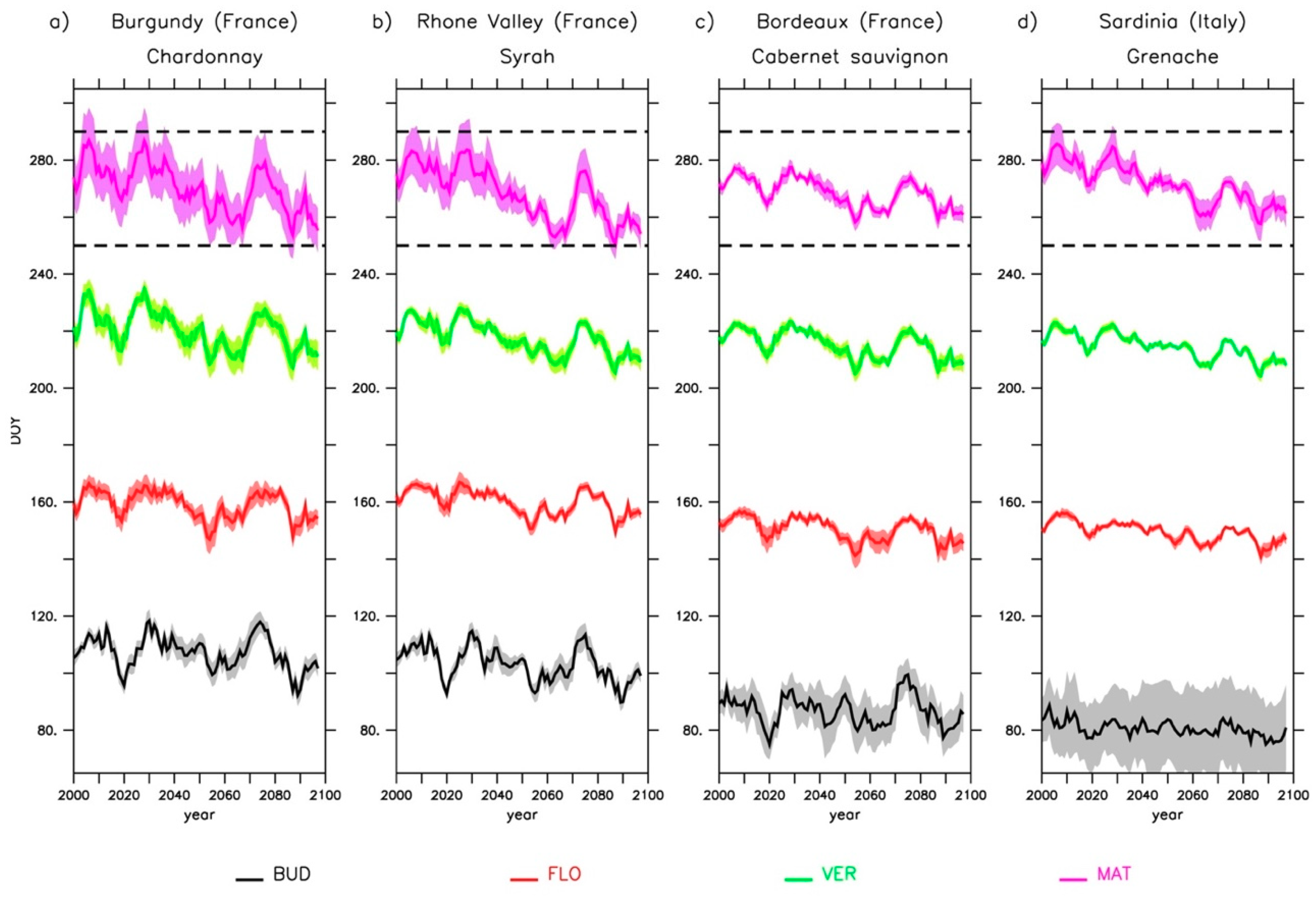
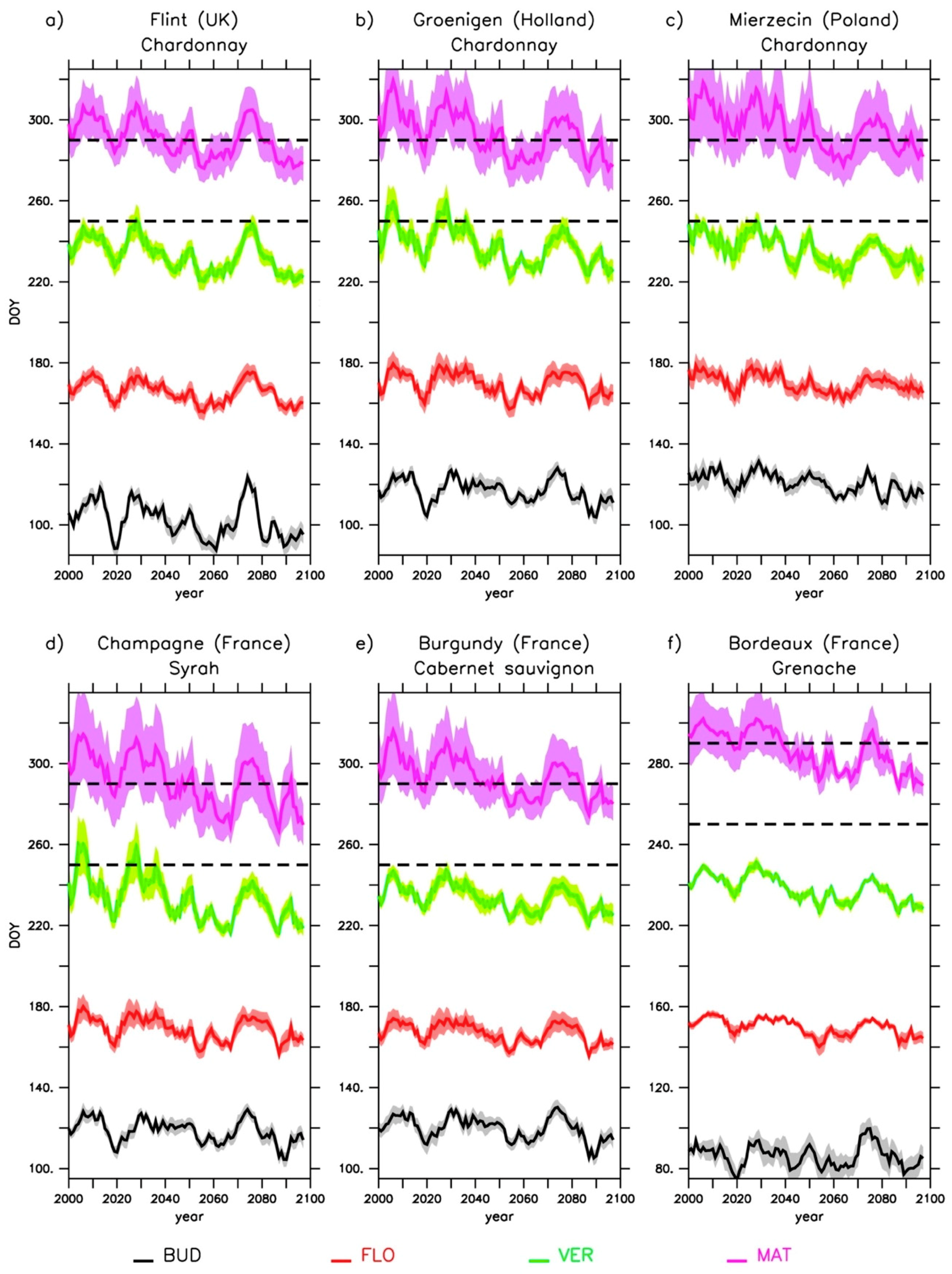
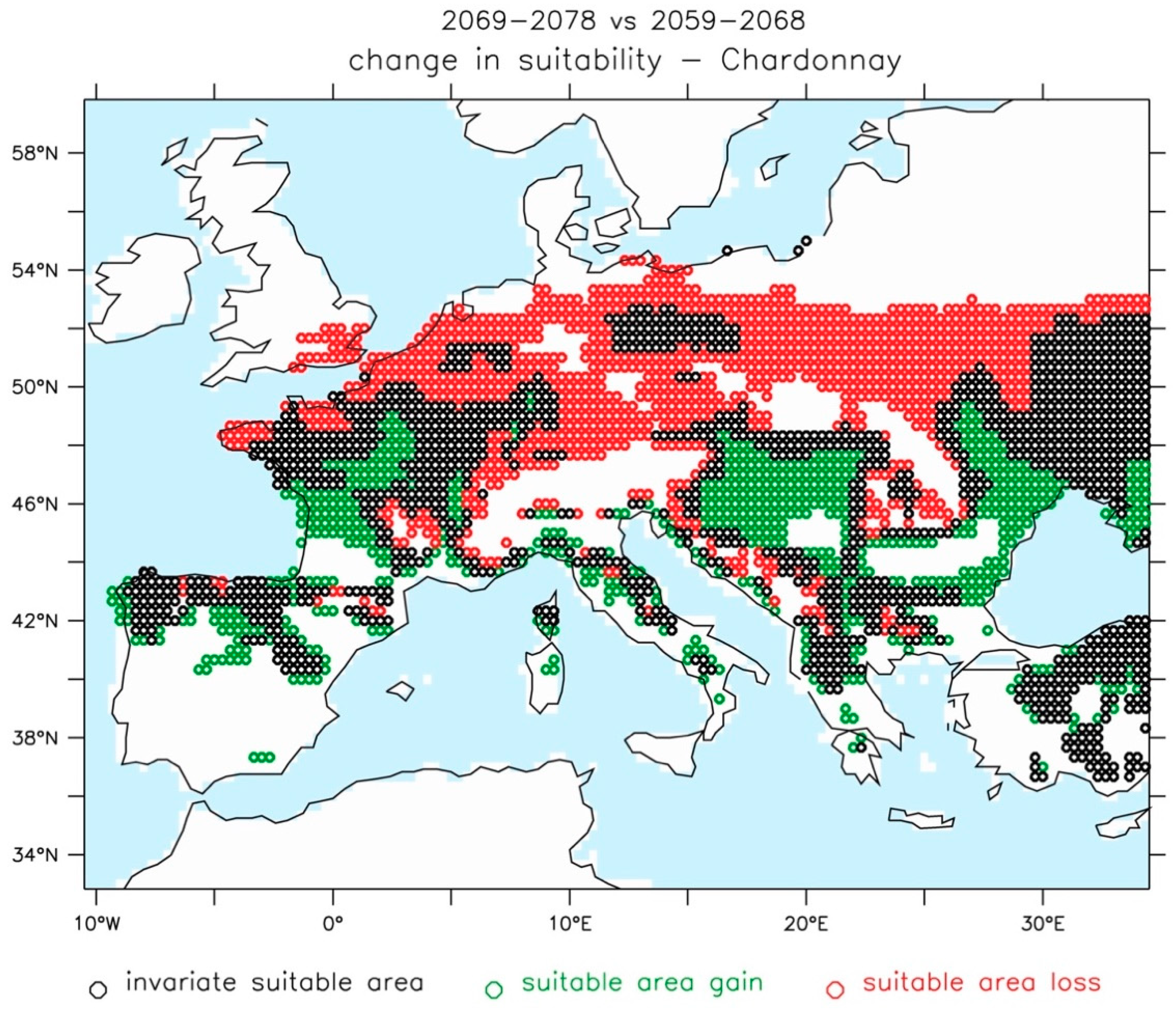
| Linear Non-Sequential | Linear Sequential | Curvilinear Sequential | |||||||||||
|---|---|---|---|---|---|---|---|---|---|---|---|---|---|
| t0 | Tb (°C) | F* | t0 | Tb (°C) | TB (°C) | F* | t0 | Tb (°C) | TB (°C) | topt (°C) | F* | ||
| Budburst | Chardonnay | DOY = 1 | 5 | 220.1 | tDB | 5 | 30 | 6577 | tDB | 5 | 30 | / | 6577 |
| Syrah | 265.3 | 7819 | / | 7819 | |||||||||
| Cabernet S. | 318.6 | / | / | 9169 | |||||||||
| Grenache | 321.3 | 9174 | / | / | |||||||||
| Flowering | Chardonnay | DOY = 60 | 0 | 1217 | tBUD | 10 | 40 | 253.9 | tBUD | 0 | 40 | 30.3 | 18.8 |
| Syrah | 1279 | 313.3 | 32.0 | 12.5 | |||||||||
| Cabernet S. | 1299 | / | 30.2 | 20.3 | |||||||||
| Grenache | 1277 | 327.7 | / | / | |||||||||
| Veraison | Chardonnay | DOY = 60 | 0 | 2547 | tBUD | 10 | 40 | 951 | tFLO | 0 | 40 | 24.3 | 56.2 |
| Syrah | 2601 | 1012 | 27.0 | 52.8 | |||||||||
| Cabernet S. | 2689 | / | 24.3 | 63.0 | |||||||||
| Grenache | 2761 | 1148 | / | / | |||||||||
| Maturity | Chardonnay | DOY = tVER | / | K = 41 | tBUD | 10 | 40 | 1675 | tVER | 0 | 40 | 24.3 | 46.0 |
| Syrah | K = 46 | 1685 | 27.0 | 43.2 | |||||||||
| Cabernet S. | K = 52 | / | 24.3 | 51.5 | |||||||||
| Grenache | K = 51 | 1926 | / | / | |||||||||
© 2019 by the authors. Licensee MDPI, Basel, Switzerland. This article is an open access article distributed under the terms and conditions of the Creative Commons Attribution (CC BY) license (http://creativecommons.org/licenses/by/4.0/).
Share and Cite
Sgubin, G.; Swingedouw, D.; García de Cortázar-Atauri, I.; Ollat, N.; van Leeuwen, C. The Impact of Possible Decadal-Scale Cold Waves on Viticulture over Europe in a Context of Global Warming. Agronomy 2019, 9, 397. https://doi.org/10.3390/agronomy9070397
Sgubin G, Swingedouw D, García de Cortázar-Atauri I, Ollat N, van Leeuwen C. The Impact of Possible Decadal-Scale Cold Waves on Viticulture over Europe in a Context of Global Warming. Agronomy. 2019; 9(7):397. https://doi.org/10.3390/agronomy9070397
Chicago/Turabian StyleSgubin, Giovanni, Didier Swingedouw, Iñaki García de Cortázar-Atauri, Nathalie Ollat, and Cornelis van Leeuwen. 2019. "The Impact of Possible Decadal-Scale Cold Waves on Viticulture over Europe in a Context of Global Warming" Agronomy 9, no. 7: 397. https://doi.org/10.3390/agronomy9070397
APA StyleSgubin, G., Swingedouw, D., García de Cortázar-Atauri, I., Ollat, N., & van Leeuwen, C. (2019). The Impact of Possible Decadal-Scale Cold Waves on Viticulture over Europe in a Context of Global Warming. Agronomy, 9(7), 397. https://doi.org/10.3390/agronomy9070397





